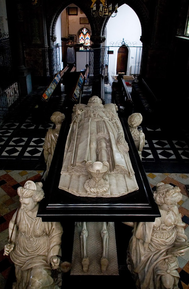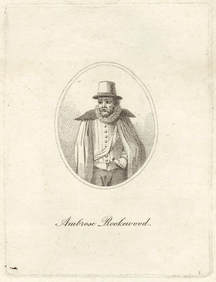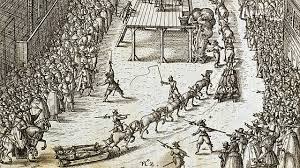As well as being immersed in political intrigue, Cecil was a dab hand at entertaining, he welcomed both Elizabeth and James to his home. He had an eye for the arts, he liked collecting paintings and even swapped one of his homes for one of the kings.
|
Robert Cecil, the first Earl of Salisbury, was small in stature. He suffered from scoliosis and was physically frail. Following in the footsteps of his father he devoted himself to the service of the crown, yet, he is described as an 'archetypal, shadowy, creepy man' operating quietly, but dangerously in the shadows. Baptised at St Clement Danes Church in London on the 6th June 1563, he was the only son of William Cecil and his second wife Mildred Cook. He entered parliament in 1534, and very quickly established himself, but was not as popular, but would go on to be a successful politician and an administrator who took over his father's role in government when he became too ill to do the job himself. In 1596, Cecil became Elizabeth's secretary and out-maneuvered her favourite Robert Devereux in what history calls the Essex's Rebellion. Cecil successfully quashed the rebellion and the Earl of Essex along with it, thus eliminating any rivals to his position as the queen's minister. He would be responsible for the smooth transfer of the crown to James VI of Scotland on Elizabeth's death in 1603. On the succession of the Scottish king, as James I, to the English throne, he temporarily lost influence as James had been a supporter of Essex, but the king came to trust and rely on Cecil, eventually calling him his 'little beagle'. In 1605, Cecil quashed yet another uprising - the Gunpower Plot, although it is thought that it was Cecil who instigated it, with the aim to convince James that he should not trust those of the Catholic persuasion. As well as being immersed in political intrigue, Cecil was a dab hand at entertaining, he welcomed both Elizabeth and James to his home. He had an eye for the arts, he liked collecting paintings and even swapped one of his homes for one of the kings. However, the burden of work eventually wore him down when in the spring of 1612, he complained of being "in great pain and even greater wretchedness of mind" and following a trip to take the waters in the town of Bath, he died of cancer on the 24th of May in 16 at Marlborough in Wiltshire. He was not yet forty-nine. Cecil was buried in St Etheldreda's Church, Hatfield in Herefordshire, and lays beneath an elaborate tomb. It is highly likely that Shakespeare was referring to Robert Cecil, as the unpopular hunchback when he was writing his play Richard III, and this is captured very well in the 2011 film Anonymous where he is portrayed as a small dark creature, underhand, and skulking about the Elizabethan corridors.
0 Comments
Ambrose Rookwoode was one of the Gunpowder Plotters, he was said to have been a ‘well-built and handsome, if somewhat short’, 'genial', ‘well-lettered’, and ‘very secret. My interest in Rookwoode in particular, was as a member of the family of Stanningfield in Suffolk who were wealthy and staunchly Catholic and his wife Elizabeth Tyrwhitt's family was also a prominent Catholic family from my local area in Lincolnshire.
It was on the 8th November 1606, at precisely 11 0'clock in the morning that over two hundred men arrived at Holbeche House where seven of the plotter were holed up. The house was surrounded and the plotters fired upon, four of them killed the other two injured including Ambrose Rookwoode. You will know the rest of this sorry tale, on the 27th January 1607, Rookwoode was taken to Westminster Hall where he pleaded guilty, three days later he was tied to a hurdle and dragged by horse from the Tower to Westminster before being hanged, drawn and quartered along with his fellow conspirators. By the end of the sixteenth century many followers of the Catholic faith had faced persecution, but had looked forward to a brighter future when King James I took the throne of England. James had promised that there would be a greater tolerance and true to his word, after his coronation in 1603, he kept his promise and restrictions on Catholicism were lifted. Almost immediately after the changes took place the king had pressure placed on him by many of the Protestant faith and he soon performed a u-turn. Angered by this, a group of men, headed by Robert Catesby, a descendant of Sir William Catesby, royal councillor and loyal friend of Richard III, plotted to blow up parliament and the king. These eight men rented a cellar below the Palace of Westminster and filled it with gunpowder, ready for the state opening of parliament on the fifth. They had previously approached Guy Fawkes who was "a man highly skilled in matters of war" and therefore an 'expert' with explosives.' The plotters plan ran smoothly, but they knew nothing of what has come to be known as the Monteagle Letter, it was this small note that was their undoing. Fawkes was arrested and through torture gave the names of his fellow conspirators These men whereabouts were discovered, two of the men had fled, one gave himself up but the rest, including Catesby stood their ground against the kings forces at Holbeche House in Staffordshire. The trial of eight of the plotters began this day the 27th January 1606. It is thought that today in 1570 Guido Fawkes was born in Stonegate, York. His date of birth is unknown but he was baptised in the church of St Michael le Belfrey on the 16th April. By the end of the sixteenth century many followers of the Catholic faith had faced persecution but had looked forward to a brighter future when King James I took the throne of England. James had promised that there would be a greater tolerance and true to his work, after his coronation in 1603, he kept his promise and restrictions on Catholicism were lifted. Almost immediately after the changes took place the king had pressure placed on him by many of the Protestant faith and he soon performed a u-turn. Twelve men were angry and they hired Fawkes. Guido Fawkes was a mercenary, a hit man, brought in to do a job, today his name has come to represent anarchy and is a byword for the other throw of government.
In this document Guy Fawkes describes how he was recruited into the famous Gunpowder Plot of 1605 while serving as a soldier in the Low Countries. It makes clear what the plotters' motives were and what they intended to do. Fawkes, who goes by the Italian name of Guido, was fighting for the Spanish army in Flanders and was known to be an explosives expert. Transcript: The Declaration of Guy Fawkes taken the 9 of November and subscribed by him the 10th day acknowledged l -- re the lordes ansswers A Thomas Winter came over into the Lowecountries unto this Examinate about Easter was twelve monethe, Exprisly to break with him about some Course to be taken for the advauncement of the Catholike Religion, which they did communicate to Owen at the camp before ^Ostend^ and three weekes after this Examinate Came into England in Company of the said Wright, by whose meanes he was made acquainted with Thomas Persy, Robert Catesby and John Wright. B They five did meete at a Howse in the fieldes beyond St Clements Inn; where they did Conferr and Agree, upon the Plott they ment to undertake and put in Execucion; and there they took a solemme Oath and vowe, by all their force and Power to Execute the same. (text omitted) C The Plott was to blowe up the kinge with all the Nobillity about him in Parlament. On the 31st January 1606, Thomas Wintour and Robert Keyes were drawn from the Tower to the Old Palace Yard at Westminster, Guy Fawkes was brought to the scaffold too, but he was made to watch as his fellow plotters were hanged and quartered. Twenty-eight-year-old Ambrose Rookwood was another of the Gunpowder Plotters who also went to the gallows that day. Rookwoode had spent over two months in the Tower of London, and below you can see a carving by Ambrose Rookwoode on the wall of the Martin Tower. There were, in fact, two men known by the name of Ambrose Rookwoode - the above-named Rookwoode and his great-grandson, a Jacobite soldier who was tried for treason and executed at Tyburn on 29 April 1696, ninety years after his namesake. However, it is not quite clear which Rookwoode was responsible for the carving, or which one of them was held in this tower. The fact that Henry Percy was held in the same tower adds weight to it being Rookwoode senior. Incidentally, for his part in the Gunpowder Plot, Henry Percy spent the following seventeen years incarcerated there. Rookwood, ‘well-built and handsome, if somewhat short’, 'genial', ‘well-lettered’, and ‘very secret.’ was a member of an ancient family of Stanningfield in Suffolk who were wealthy and staunchly Catholic. His wife, Elizabeth Tyrwhitt's family were also a prominent Catholic family from Lincolnshire.
By the end of 1605, according to his confession, Rookwoode was approached by Catesby, Winter, and Wright, he stated that he hadn't known the reason for supplying the men with gunpowder at a house in Lambeth. This may be true, Catesby, as the ring leader, was a determined man and also charming and it may be that Rookwoode was easily persuaded. After the capture of Fawkes, Rookwoode was among the men fighting the king's forces at Holbeche House in Staffordshire, he was shot in the right arm and his face burnt, he was captured and taken to London and 'questioned at great length.' During his trial, he stated that he was led astray by Catesby and pleaded not guilty. Labeled a traitor, he was destined for a traitor's death, four days after his trial he was drawn to his death. Rookwoode asked to be taken past his home where his dutiful wife Elizabeth was waiting at the window, he is said to have shouted 'Pray for me, pray for me!' Rookwoode met his death on the gallows at Westminster Yard, even though he showed remorse, he was left to hang for longer than the others, a small mercy perhaps - he would be dead before they disemboweled him! Apart from Guy Fawkes, do you know the names of the eight Gun Powder Plotters? Not many people do, but it's Fawkes who is synonymous with the events of 1605. Fawkes was a mercenary, a hit man, brought in to do a job and if wasn't for a letter, no one knows who sent it, we would never have heard of him. Instead, Fawkes has come to represent anarchy and is the byword for the overthrow of the government. Today, as a nation, we celebrate the discovery of the plot with fireworks and a bonfire and in days gone by with an effigy of a 'Guy' placed on top. This ritual continues as unpleasant entertainment which is representative of the barbaric practices of our ancestors. On the 26th October 1605 William Parker, Lord Monteagle received a letter from an anonymous source warning him not to attend parliament when it resumed in the next few days. The letter, with reference to the government, stated My lord, out of the love I bear to some of your friends, I have a care of your preservation, therefore I would advise you as you tender your life to devise some excuse to shift your attendance at this parliament, for God and man have concurred to punish the wickedness of this time, and think not slightly of this advertisement, but retire yourself into your country, where you may expect the event in safety, for though there be no appearance of any stir, yet I say they shall receive a terrible blow this parliament and yet they shall not see who hurts them, this counsel is not to be condemned because it may do you good and can do you no harm, for the danger is past as soon as you have burnt the letter and I hope God will give you the grace to make good use of it, to whose holy protection I commend you Transcript of Letter to Lord Monteagle 26 October 1605 Monteagle left his home and passed this letter to the secretary of state Robert Cecil, who in searching the cellars under the Palace of Westminster found evidence of the truth of the letter in the form of thirty-six barrels of gunpowder and hiding among the barrels was one Guy Fawkes. By the end of the sixteenth century, many followers of the Catholic faith had faced persecution but had looked forward to a brighter future when King James I took the throne of England. James had promised that there would be greater tolerance and true to his word, after his coronation in 1603, he kept his promise, and restrictions on Catholicism were lifted. Almost immediately after the changes took place the king had pressure placed on him by many of the Protestant faith and he soon performed a U-turn Angered by this, a group of men, headed by Robert Catesby, a descendant of Sir William Catesby, royal councilor and loyal friend of Richard III, plotted to blow up parliament and the king. These eight men rented a cellar below the Palace of Westminster and filled it with gunpowder, ready for the state opening of parliament on the fifth. They had previously approached Guy Fawkes who was "a man highly skilled in matters of war" and therefore an 'expert' with explosives.' The plotter's plan ran smoothly, but they knew nothing of what has come to be known as the Monteagle Letter, it was this small note that was their undoing. Fawkes was arrested and through torture gave the names of his fellow conspirators. These men's whereabouts were discovered, two of the men had fled, and one gave himself up but the rest, including Catesby, stood their ground against the king's forces at Holbeche House in Staffordshire. The trial of eight of the plotters began on 27 January 1606. Four days later, Fawkes, Thomas Wintour, Ambrose Rookwood, and Robert Keyes were drawn from the Tower to the Old Palace Yard at Westminster where Fawkes watched as his fellow plotters were then hung and quartered. Despite what is usually thought Guy Fawkes did not receive the same fate, before they were able to tie the noose around his neck, Fawkes managed to jump from the gallows and broke his neck in the fall. His body was quartered and distributed to 'the four corners of the kingdom' to be placed on display. What would have happened if this plan had come to fruition? Would there have been, as we have seen in times past, an underaged king on the throne and a protector appointed or would there have been a civil war with the followers of the Protestant and Catholic religions fighting it out on the battlefield?
|
Archives
February 2024
Categories
All
After ten years in the workplace I became a mother to three very beautiful daughters, I was fortunate enough to have been able to stay at home and spend my time with them as they grew into the young women they are now. I am still in the position of being able to be at home and pursue all the interests I have previously mentioned. We live in a beautiful Victorian spa town with wooded walks for the dog, lovely shops and a host of lovely people, what more could I ask for.
All works © Andrea Povey 2014. Please do not reproduce without the expressed written consent of Andrea Povey. |

















 RSS Feed
RSS Feed
